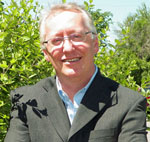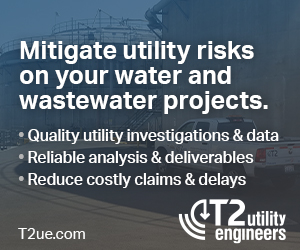 |
||||||||||||||||||||
| Subscribe | Past Issues | www.cwwa.ca | Water Source Magazine | ||||||||||||||||||||
|
CWWA News
Warning: There is a call to action at the end of this column. First, instead of reading this column, you should be packing your bags to go to Winnipeg for the National Water & Wastewater Conference…or on the way to the airport…or at the airport. But if you are not, I promise you will regret it later when you hear how great it was.
Federal Initiatives
The Canadian Minister of Health has announced its intention to update drinking water quality guidelines for radionuclides, from 0.1 millisieverts per year (mSv/y) to 1 mSv/y. It would also update maximum concentration values (MACs), by removing the MAC for uranium and establishing MACs “for the most significant radionuclides, including radium-228 (Ra-228), and new health-based values (HBVs) for other radionuclides of interest, including polonium-210 (Po-210) and radon-222 (Rn-222).” CWWA’s Drinking Water Quality Committee will review the proposed guideline and submit comments if necessary. The Canadian government is updating the Canadian Environmental Protection Act, 1999 (CEPA), affirming the right to a healthy environment and enhancing chemical management and transparency. CEPA now mandates consideration of cumulative effects of substances during risk assessments, focusing on vulnerable populations. A Plan of Priorities will be released, listing over 30 substances for assessment to protect health and the environment, including a focus on PFAS, with a commitment to further study fluoropolymers. FCM Connect On the route to net-zero emissions, Canadian municipalities need to know where they stand today. The new database from the Municipal Net-Zero Action Research Partnership (N-ZAP) provides an important snapshot of the state of climate action in local governments across Canada. These survey findings can guide your decision-making as you set ambitious targets for the reduction of GHG emissions and continue to move forward on the route to net zero. Canadians rely on both transportation and water infrastructure in their day-to-day lives, whether it be the roads they drive on or the water source in their homes. Statistics Canada, in partnership with Infrastructure Canada, has released 2022 data that provide a snapshot of transportation and water infrastructure across the country through Canada’s Core Public Infrastructure Survey. These data help all levels of government to develop more evidence and results-based policies to improve Canada’s core public infrastructure, and to monitor and report on the progress of these investments. If you have questions or would like to speak to an analyst, please contact infostats@statcan.gc.ca
Provincial News
Alberta is funding nearly $3 million of a $6.1-million study by Varme Energy for Canada’s first waste-to-energy facility with carbon capture, aiming to start in 2027. The plant will convert landfill waste into electricity, capturing 185,000 tonnes of CO₂ yearly for sequestration. The project, supported by Emissions Reduction Alberta, Gibson Energy, the City of Edmonton, and the Canada Growth Fund, will divert 200,000 tonnes of waste from landfills annually, creating a carbon-negative system. The facility, to be located on Gibson Energy’s property near Edmonton, will complete its design study by December 2024, with construction beginning in 2025. While this project is using landfill waste, research into gas capture and energy conversion are great case studies that will help advance projects using wastewater. PEI has launched new guidelines for the province's Climate Challenge Fund which supports innovative climate change solutions. Key requirements include project eligibility criteria, funding contributions, and evaluation processes for applicants seeking financial support for climate action initiatives. This document applies to First Nations, municipalities, businesses, academic institutions, organizations representing culturally diverse communities, and not-for-profit organizations in Prince Edward Island. The Ontario government is allocating an additional $5 million for the 2024-25 Community Emergency Preparedness Grant (CEPG) to enhance local emergency readiness. This funding, part of a $110 million three-year initiative, will provide municipalities and organizations with resources, equipment, and training for better disaster and emergency response. Eligible entities in Ontario can apply until October 31, 2024, and include various municipal, Indigenous, and non-governmental organizations. The 2023-24 CEPG supported 113 recipients, but those recipients are now ineligible to ensure wider distribution of funds. Applicants require a My Ontario Account and must register for Transfer Payment Ontario, with information sessions available for guidance. Water Canada The widespread presence of PFAS (Per- and polyfluoroalkyl substances), commonly known as “forever chemicals,” has been detected in Quebec’s drinking water, prompting legal action. A comprehensive study by the Université de Montréal last year found PFAS in 99.3% of drinking water samples from 376 municipalities across the province. The findings have raised concerns, especially after Health Canada proposed a new guideline earlier this year, setting a limit of 30 nanograms per litre (ng/L) for total PFAS in drinking water. Snippings & Clippings
OHS Canada Yukon officials say they are working to understand how groundwater moves through an area where a failure at a mine released millions of tonnes of cyanide-laced ore into the surrounding environment, about 480 kilometres north of Whitehorse. Water Online Per- and polyfluoroalkyl chemicals, known commonly as PFAS, could take over 40 years to flush out of contaminated groundwater in North Carolina’s Cumberland and Bladen counties, according to a new study from North Carolina State University. The study used a novel combination of data on PFAS, groundwater age-dating tracers, and groundwater flux to forecast PFAS concentrations in groundwater discharging to tributaries of the Cape Fear River in North Carolina. Water Online At least 20% of the population in the US relies on drinking water that has been contaminated with PFAS, according to a US Geological Survey study published Thursday. The untreated water supply for as many as 95 million people in the contiguous US uses drinking water that has detectable levels of per- and polyfluoroalkyl substances (PFAS), which have been linked to cancer and other diseases, according to the research published in the journal Science. Stateline Legislative momentum against PFAS has surged this year, as at least 11 states enacted laws to restrict the use of “forever chemicals” in everyday consumer products or professional firefighting foam. The legislation includes bans on PFAS in apparel, cleaning products, cookware, and cosmetic and menstrual products. Meanwhile, lawmakers in some states also passed measures that require industries to pay for testing or cleanup; order companies to disclose the use of PFAS in their products; and mandate or encourage the development of PFAS alternatives, according to Safer States, an alliance of environmental health groups focused on toxic chemicals. E&E News A first-of-its-kind ruling on the health risks of the tooth-strengthening chemical fluoride could open the floodgates to an influx of other efforts to compel EPA action, creating uncertainty for the agency, experts say. The decision — precedent-setting for Toxic Substances Control Act citizen petitions — represents a rare occasion in which a judge disagreed with federal officials on the science, forcing EPA to regulate against its wishes. Associated Press It takes water to flush a toilet and tens of thousands of North Carolinians have been without it since Hurricane Helene ripped through the state three weeks ago. When Lark Frazier went around asking her Asheville neighbors how they were doing as far as water to flush, several burst into tears over the stress of where to go to the bathroom and what to do with the waste. American Society of Civil Engineers The U.S. Environmental Protection Agency’s October 16 deadline is fast approaching and water utilities across the U.S. are preparing to submit their inventories of lead service lines, a key provision of the Lead and Copper Rule Revisions. Finalized in December 2021, the LCRR is part of a multiyear regulatory framework to address the public health risks posed by lead service lines. The Water Network by AquaSPE About 2.2 billion people, more than a quarter of the world's population, lack access to safe, managed drinking water, and about half of the world's population experiences severe water scarcity at some point during the year. To overcome these shortages, huge socioeconomic costs are being spent on sewer irrigation and alternative water sources such as rainwater reuse and seawater desalination. Furthermore, these centralized water distribution systems have the disadvantage of not being able to respond immediately to changes in water demand. Therefore, there is a growing interest in decentralized water production technologies, which are electrochemical-based technologies that are easy to adopt, such as capacitive deionization and battery electrode deionization (also known as faradaic deionization). However, the existing water quality measurement sensors used in electrochemical-based technologies do not measure and track individual ions in water, and have the limitation of roughly inferring water quality conditions from electrical conductivity. Water Canada The City of Calgary has lifted all Stage 4 water restrictions, effective immediately, following the successful connection of the Bearspaw South feeder main to the city’s water distribution system. With the system now stabilized and reservoirs refilled, Calgarians can resume normal water use both indoors and outdoors. |
||||||||||||||||||||









